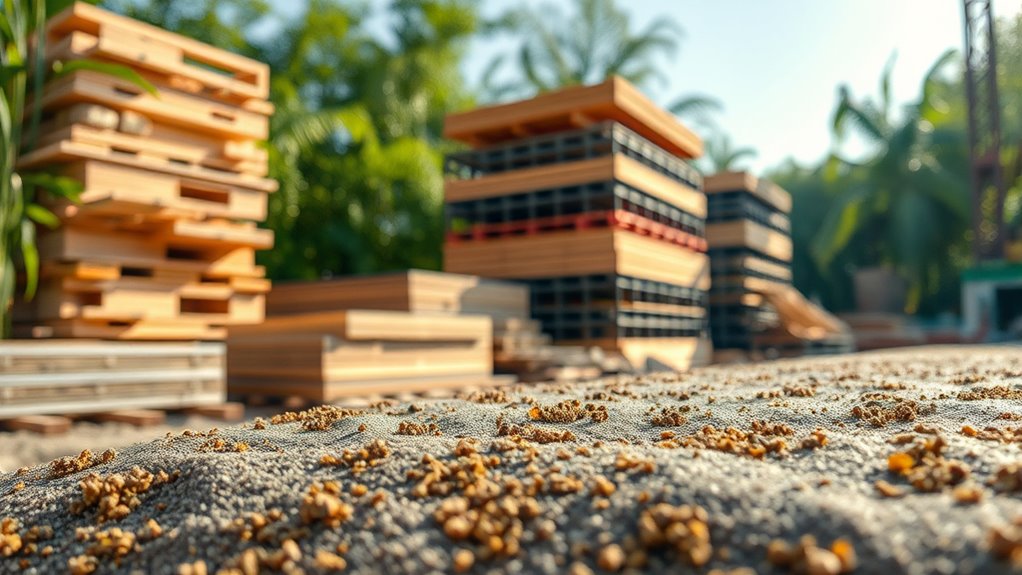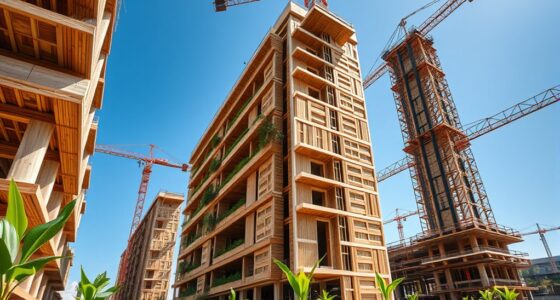The secret science behind carbon-neutral building materials lies in innovative techniques that reduce environmental impact throughout their lifecycle. Researchers focus on sustainable sourcing of renewable or recycled raw materials, utilizing advanced assessment tools like lifecycle analysis to pinpoint emission hotspots. They also incorporate bio-based composites and renewable energy in manufacturing to cut emissions further. By balancing impacts at every stage, these materials help create genuinely eco-friendly structures. Keep exploring to discover how these cutting-edge practices can transform construction.
Key Takeaways
- Advanced lifecycle assessments identify emission hotspots, guiding the development of low-carbon building materials.
- Bio-based composites from renewable resources reduce reliance on resource-intensive extraction processes.
- Incorporating renewable energy into manufacturing minimizes emissions during material production.
- Sustainable sourcing prioritizes recycled and reclaimed materials, lowering environmental footprints.
- Innovative measurement and optimization techniques enable precise balancing of impacts throughout the material’s lifecycle.

As the demand for sustainable construction grows, carbon-neutral building materials are emerging as a vital solution to reduce the environmental impact of construction projects. These materials are designed not only to minimize carbon emissions during production and use but also to guarantee their entire lifecycle is eco-friendly. To achieve this, manufacturers focus heavily on sustainable sourcing, which involves selecting raw materials that have a low environmental footprint. Sustainable sourcing means choosing materials that are renewable or recycled, reducing dependency on resource-intensive extraction processes. For example, using recycled steel or reclaimed wood minimizes waste and lowers the energy required to produce new materials. By prioritizing sustainable sourcing, builders cut down on emissions associated with raw material extraction and processing, making the entire supply chain more environmentally responsible.
However, choosing sustainable materials isn’t enough; you need to understand their full environmental impact. That’s where lifecycle assessment (LCA) comes into play. LCA is a detailed method that evaluates the environmental impacts of a product from cradle to grave—covering raw material extraction, manufacturing, transportation, usage, and disposal. When you incorporate LCA into your decision-making process, you gain insight into which materials truly reduce your carbon footprint over their lifespan. For instance, a material with a low initial carbon footprint might have a higher impact during disposal or recycling phases. By analyzing these stages, you can select options that deliver the greatest overall environmental benefits.
Lifecycle assessment reveals true environmental impacts, guiding smarter choices for sustainable, low-carbon building materials.
The secret science behind carbon-neutral building materials lies in this meticulous approach to sourcing and assessment. Manufacturers employ advanced techniques to measure and optimize each stage, ensuring that the materials you use contribute as little as possible to global warming. This involves harnessing innovations like bio-based composites, which are made from renewable biological resources, and integrating renewable energy sources into manufacturing processes. These efforts are complemented by rigorous lifecycle assessments that help identify potential hotspots of emissions, guiding improvements and innovations.
In essence, the science is about balancing environmental impacts at every step. It’s about making smarter choices—choosing materials with sustainable sourcing that are verified through thorough lifecycle assessments. This integrated approach allows you to build structures that are genuinely carbon-neutral, supporting a greener future. By understanding and applying these principles, you play a key role in transforming construction from an industry with significant environmental costs into one that champions sustainability and climate responsibility.
Frequently Asked Questions
How Do Carbon-Neutral Materials Compare Cost-Wise to Traditional Options?
When you look at the cost comparison between carbon-neutral materials and traditional options, you’ll find that initially, eco-friendly choices can be more expensive. However, their economic feasibility improves over time due to lower energy costs and potential incentives. You should consider the long-term savings and environmental benefits, which often outweigh the higher upfront investment. Overall, investing in carbon-neutral materials makes sense both financially and sustainably.
What Are the Challenges in Sourcing Sustainable Materials at Scale?
You face challenges sourcing sustainable materials at scale, from maneuvering complex supply chains to ensuring material durability. Limited availability and fluctuating demand strain logistics, making it hard to maintain consistent supply. You also worry about durability, fearing that eco-friendly options might not last as long. Overcoming these hurdles requires building resilient supply chains, prioritizing durable materials, and fostering innovations to meet growing sustainability goals efficiently and reliably.
Can Existing Buildings Be Retrofitted With Carbon-Neutral Materials Effectively?
You can retrofit existing buildings with carbon-neutral materials effectively by leveraging urban planning and policy incentives. These strategies encourage upgrades that reduce emissions and improve energy efficiency. With proper planning, you’ll find sustainable options that fit your building’s needs, making the process smoother. Policy incentives, like grants or tax breaks, motivate faster adoption. Overall, integrating these approaches helps you transform older structures into eco-friendly spaces seamlessly.
How Long Do Carbon-Neutral Building Materials Typically Last?
Imagine a building standing tall, its eco-friendly materials aging gracefully. You wonder how long these carbon-neutral materials last, and the answer depends on durability testing and the material lifecycle. Typically, they last as long as conventional options—decades—if properly maintained. Advances in testing assure they’re resilient, but factors like climate and usage influence longevity, so regular assessments help maximize their lifespan and maintain sustainability.
Are There Certification Standards for Carbon-Neutral Building Materials?
You’ll find that certification standards for carbon-neutral building materials involve strict certification processes to guarantee quality assurance. These standards verify that materials genuinely reduce carbon footprints and meet sustainability criteria. By adhering to recognized certifications, you can confidently choose environmentally responsible options, knowing they’ve been rigorously tested. Certification helps you maintain high quality, supports sustainable building practices, and guarantees that your materials align with industry benchmarks for carbon neutrality.
Conclusion
By choosing carbon-neutral building materials, you help reduce global CO₂ emissions, which account for about 39% of all human-caused greenhouse gases. Imagine your next project contributing to a healthier planet—it’s a powerful step towards sustainability. Every building material you select can make a difference. So, when you opt for eco-friendly options, you’re not just constructing a structure; you’re helping fight climate change and protect future generations. Your choices truly matter.










